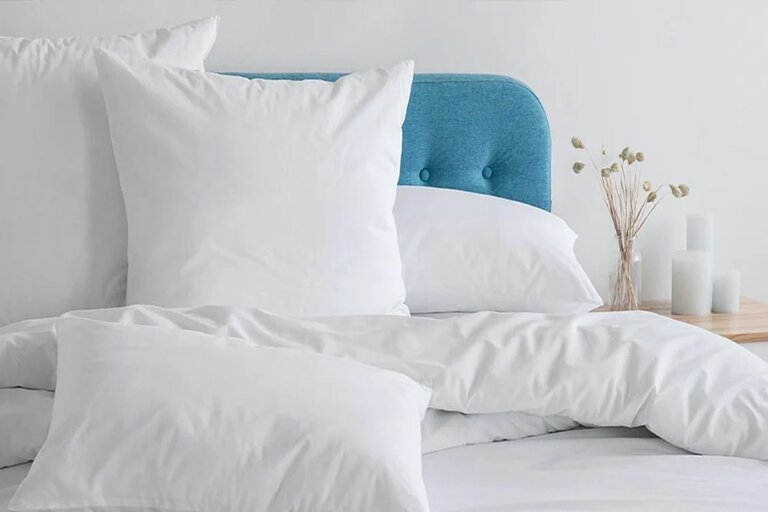If you are suffering from allergies, the right bed, how well you sleep at night, could make a world of difference. Dust particles, pollen, and pet denders can be just what the allergy needs to get going. Allergies can make restful sleep feel impossible, with sneezing, itchy eyes, congestion, and even difficulty breathing disrupting your nights. If you’re waking up feeling worse than when you went to bed, your bedding could be the reason.By limiting exposure to common allergens, selecting the finest sheets and bedding for allergies will greatly lessen these symptoms. Let us examine how sleeping with hypoallergenic bedding can improve your quality of life.
Why Does Bedding Matters for Allergy Sufferers?
Your bed can implement allergies such as dust particles, mold and pets. These small particles can trigger symptoms of sneezing, itchy eyes and other allergies. By choosing the right bed material, you can reduce this irritable contact and create a cleaner, healthy sleep environment.
How to Identify If Your Bedding Is Causing Allergies:
There is no guarantee that you will know if your bedding is exacerbating your condition, but waking up with itchy eyes, a runny nose, or skin irritation that subsides during the day might be a clue that your bedding is the culprit. Continuous sneezing, coughing, or wheezing at night can also suggest that you have allergens on your sheets or pillowcases. Check for dust settling or bad odor, and identify if your bed symptoms occur due to a certain period of a change in beddings.
How does anti-allergy bedding work?
Put simply, anti-allergy bedding, or dust mite allergy bedding, works by reducing or eliminating allergens from your comforter, pillows, mattress and more, helping to reduce the symptoms associated with night-time allergies. While there are many possible triggers of allergies at night, the most common ones include dust mite allergens and fungal spores. These are the main allergens that anti-allergy bedding is designed to eliminate.
Hypoallergenic Bedding Options:
Of course, you can reduce the effect of allergies by investing in the hypoeller -genetic sheet, channels and covers. Here are some materials that can help with allergies.
Best Bedding Materials for Allergy Sufferers:
When choosing a bed for allergies, it is important to find materials that are less likely to trap allergies. Here are the best options:
1.Cotton Bedding:
Cotton is hypoallergenic by nature and comfortable, breathable, and durable. Besides fighting allergens, it can help with symptoms such as stuffiness and swollen sinuses by helping regulate your temperature.
Look out for cotton sheets that are sustainably sourced for a minimal impact on the environment. The other sheets labeled “sateen” are also made of cotton. Sateen simply refers to the weave and means the sheets have a buttery, soft feeling that can help you have a good night’s sleep.
2.Bamboo Sheets:
Bamboo is yet another hypoallergenic but also antimicrobial material. This bamboo resists mold and other microorganisms; therefore, it would be appropriate for those who might not be able to point exactly what it is they’re allergic to.
You can find 100% bamboo sheets as well as blends with other fibres such as rayon.Bamboo is soft and comfortable, although some users note that bamboo sheets may soften up after washing regularly.
3.Hypoallergenic Pillows:
Pillows filled with synthetic materials such as polyester or memory foam are a good choice because they do not attract dust particles such as natural fillers (eg bottom spring). Look for pillows marked as the hypoallergenic.
4.Allergy-Proof Mattress Protector:
A tight-weave mattress protector will keep dust mites and other allergens from entering your mattress. This is important because a mattress is one of the best places for dust mites to multiply. For comfort, make sure to choose breathable material for the protector.
5.Hypoallergenic Comforters:
New forces filled with hypoallergenic materials such as cotton, silk or wool are a good alternative. They are less likely to disrupt dust particles and allergies other than synthetic or down from comfort.
How to Keep Your Bedding Allergy-Free:
Buying the right bedding is just the first step. Proper care should always be taken so that your bedding remains allergen-free. The following are some simple tips.
1.Wash Bedding Frequently:
Wash your bedding sheets, pillowcases, and blankets – in hot water at least every 1-2 weeks (130°F or 54°C or hotter) to kill dust mites and get rid of allergens.
2.Use Allergen Proof Covers:
Invest in allergen-proof pillow and mattress covers. These coverings are specifically designed to keep allergens from entering your bedding.
3.Change Your Sheets Every Few Days:
And, above all, when the weather is warm, it becomes even more important. Try changing your sheet at least one day earlier than you do now.
4.Use an Air Purifier:
An air purifier with a HEPA filter can help remove air allergies such as dust, pollen and pets, making you easier to breathe while sleeping.An air purifier with a HEPA filter can help remove air allergies such as dust, pollen and pets, making you easier to breathe while sleeping.
Allergies can make you sleep better by changing the bed. Choosing hypoallergenic pads, sheets, cancer, and mattress protector will create a cleaner and comfortable sleep environment. Moreover, the steps to keep your bed clean and healthy will help you breathe and get better sleep.
For more information on the bedding & fashion trends,visit our website https://trendythreads.net/.




